Examining Laboratory-Created Diamonds from a Mineral Viewpoint
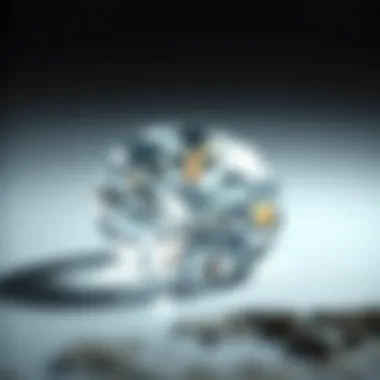
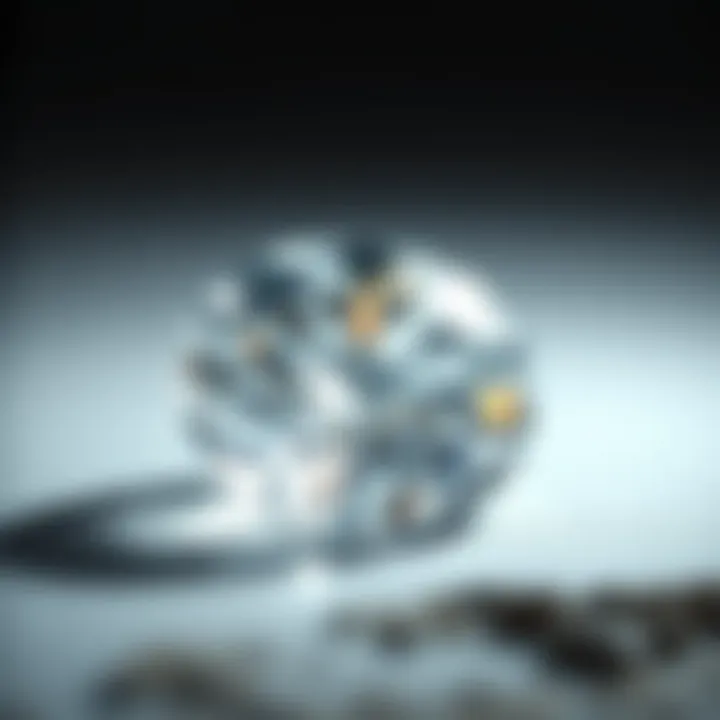
Intro
The emergence of laboratory-created diamonds has stirred a pot of debates, discussions, and curiosity, particularly within the rock and fossil collecting community. To some, these are mere man-made imitations, while others recognize their impressive chemistry and relevance in the collection circuit. This article provides a fresh take on the topic, aiming to unravel the complex layers of classification and their impact on both collectors and enthusiasts alike.
Anchored firmly in geological contexts, this narrative will navigate through the origins, identifications, distinctions from natural diamonds, and societal perceptions surrounding these intriguing gemstones. Understanding these aspects not only enriches one’s knowledge but also helps in making informed collection choices. Notably, the conversation extends beyond mere definitions; it explores how our views on these stones are evolving in a world where innovation is at the forefront.
History and Origins
Overview of Collectibles, Rocks, and Fossils
When we delve into the world of collectibles, it’s essential to acknowledge the long-standing human fascination with minerals and gemstones. From the ancient Egyptians who adorned themselves with turquoise and lapis lazuli to the modern enthusiasts captivated by rare fossils and gems, the quest for unique specimens remains timeless. Correlating this with laboratory-created diamonds unveils an intriguing dynamic.
While natural diamonds have their origins buried deep within the Earth, formed under conditions of extreme pressure and temperature over millions of years, lab-created diamonds arise from a mix of science and creativity. These stones are created through methods like High Pressure High Temperature (HPHT) and Chemical Vapor Deposition (CVD), each offering a unique process that replicates the natural formation of diamonds. A particularly interesting aspect here is the rapidity of their production. Unlike natural counterparts, which require eons to develop, lab diamonds can be crafted in a matter of weeks.
Historical Significance and Cultural Impact
The significance of diamonds stretches far beyond their geological formation. Culturally, they have represented wealth, power, and status throughout history. With the onset of synthetic diamonds, however, we observe a shift in this perception. For one, laboratory-created diamonds offer a more ethical alternative to natural stones often linked to conflict and environmental degradation.
Many collectors have begun to embrace these lab-generated variations, seeing them not only as ethically responsible choices but also as scientifically fascinating creations. The cultural dialogue surrounding these stones continues to evolve, challenging traditional notions of value and desirability within the diamond market. In this light, lab-created diamonds emerge not only as collectibles but also as symbols of a changing landscape in the way choices are made regarding what is cherished.
"While natural diamonds exude their charm through history and rarity, lab-created diamonds redefine value and ethics in a modern context."
In summary, the history of diamonds, both natural and artificial, reflects a distinct narrative of human progress, innovation, and shifting values. As we delve further into the article, we will examine the identification and classification of these intriguing stones, ensuring to clarify their places within the respective realms of geology and collector culture.
Understanding Diamonds
In the realm of geology and mineral classification, understanding diamonds is akin to unearthing hidden treasures beneath the earth's surface. Diamonds are not merely sparkling stones; they are the absolute pinnacle of carbon crystalline forms, deeply embedded in cultural, industrial, and even scientific narratives. Their extraordinary properties and formation process invite a closer examination, particularly when contrasting natural diamonds to their laboratory-created counterparts. By exploring the intricate relationship diamonds have with their environments and the nuanced methods of their creation, we deepen our appreciation for these remarkable gems.
What Defines a Mineral?
To grasp the essence of diamonds, one must first comprehend what defines a mineral. A mineral, by conventional criteria, is a naturally occurring inorganic solid with a definite chemical composition and an ordered internal structure. This definition sheds light on several characteristics:
- Solid State: Unlike liquids and gasses, minerals maintain a solid state, contributing to their distinct physical properties.
- Naturally Occurring: A material must form through natural geological processes and not synthetically to qualify as a mineral.
- Definite Chemical Formula: Each mineral possesses a specific chemical composition, leading to variations in properties among different minerals.
Consider rock salt as a prime example. It's natural, solid, and its formula is straightforward—NaCl. Knowing these traits helps set the stage for distinguishing between natural and synthetic forms that may seem similar at first glance.
The Chemical Composition of Diamonds
Diamonds are fundamentally composed of carbon atoms arranged in a specific lattice structure, resulting in unparalleled hardness and optical properties. This unique formation is what sets diamonds apart in both industrial and jewelry applications. The simplicity of their chemical makeup belies the complexity of their characteristics:
- Carbon Lattice: The arrangement of carbon atoms in a tetrahedral configuration yields strength and brilliance. This is where diamonds draw their revered status.
- Impurities Influence: When other elements infiltrate this structure, they can alter the color and properties of the diamond; for instance, nitrogen can yield a yellow tint while boron can yield a striking blue.
Such insights about chemical composition are crucial, especially when comparing the properties of natural diamonds against those created in laboratories.
Natural vs. Synthetic Diamonds
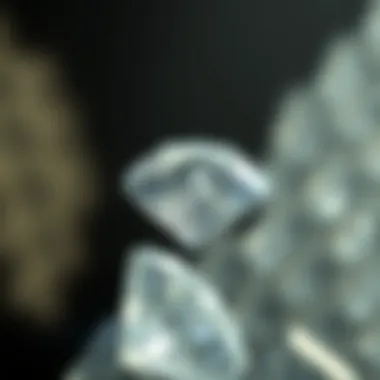
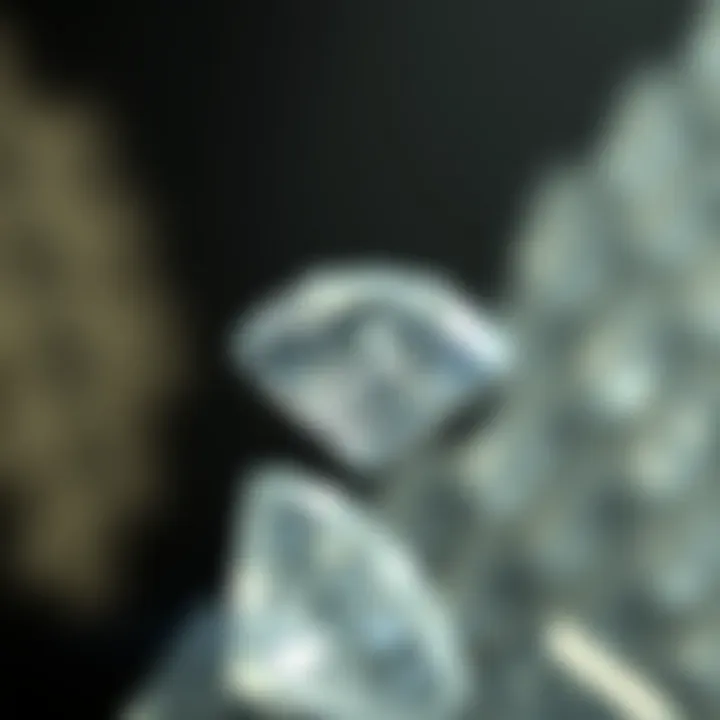
The discussion around natural and synthetic diamonds invariably raises the question of authenticity. Natural diamonds have endured eons of geological activity, while synthetic diamonds are crafted through innovative techniques that simulate these processes. Here are key distinctions:
- Formation Process: Natural diamonds form under extreme conditions within the Earth's mantle over billions of years, whereas synthetic variants can emerge in days or weeks through methods like High Pressure High Temperature and Chemical Vapor Deposition.
- Environmental Impact: The extraction of natural diamonds often raises ecological and ethical concerns, while many laboratory-created diamonds tout a lower environmental footprint.
- Market Perception: There's an ongoing debate regarding value and desirability; while some collectors regard natural diamonds as more authentic, others see the brilliance and accessibility of lab-grown diamonds as equally valuable.
"Synthetic diamonds increasingly challenge traditional perceptions, leaving room for a fresh conversation in gemology."
Ultimately, both forms have their place in the market, yet the distinctions define their respective narratives within the diamond community. Understanding these differences is important, especially for those passionate about collecting and appreciating the subtleties of geology.
By delving deep into the facets of diamonds, we empower rock and fossil collectors, enthusiasts, and novices alike to refine their knowledge and appreciation of these extraordinary materials.
The Process of Creating Laboratory Diamonds
The creation of laboratory diamonds represents a significant chapter in the story of gemstones. By understanding the processes employed in their synthesis, one gains insight into the nuances distinguishing them from their naturally occurring counterparts. These techniques are not simply about replacing nature; they encompass a multitude of benefits such as ethical sourcing, sustainability, and cost-effectiveness. Recognizing the procedures allows both collectors and enthusiasts to appreciate the craftsmanship behind these stones while engaging in a discourse on their place in the mineral classification spectrum.
Techniques for Diamond Synthesis
Two main techniques dominate the field of diamond synthesis: High Pressure High Temperature (HPHT) and Chemical Vapor Deposition (CVD). Both are revolutionary, yet they each bring unique characteristics and advantages that cater to different objectives in diamond creation.
High Pressure High Temperature (HPHT)
The HPHT method mimics the natural processes that form diamonds deep within the Earth. By subjecting carbon to extreme pressures and temperatures, this technique orchestrates the conditions necessary for diamond crystallization. One of the key characteristics of HPHT is its ability to produce diamonds that resemble natural gems in clarity and color.
However, this method isn't without its downsides. The complex machinery needed for HPHT can involve substantial energy and costs, but for many, the benefits outweigh the challenges. It offers an appealing choice for those looking to produce high-quality diamonds that can be virtually indistinguishable from nature's creation.
Unique to HPHT is its capability to create colored diamonds by introducing specific elements into the carbon mix during synthesis. This aspect not only diversifies offerings in the market but also enhances creative opportunities for jewelers and designers. Despite its advantages, the technology demands precision and can introduce variations based on the conditions controlled during the process.
Method (Chemical Vapor Deposition)
On the other end, we have the CVD method, which provides a different approach to diamond synthesis. Instead of compressing carbon under extreme pressure, CVD plants seeds of diamond crystals and utilizes gases (primarily methane) to deposit carbon in a controlled environment. The process occurs at lower temperatures than HPHT and is known for producing high-purity diamonds with fewer inclusions.
CVD's key characteristic is its flexibility in production, allowing for a variety of diamond shapes and sizes. While it can produce diamonds at a fraction of the cost associated with HPHT, it may not always achieve the same color variety without additional treatment processes.
Moreover, CVD diamonds are often more consistent in quality, making them a preferred choice for both industrial applications and fine jewelry. Nevertheless, like HPHT, CVD has its own idiosyncrasies that can make large-scale, immediate production a challenge depending on the required specifications.
Comparison of Synthesis Techniques
When comparing HPHT and CVD methods, several factors come into play:
- Quality: Both methods can produce high-quality gems, though HPHT typically yields stones with more natural colors.
- Cost: CVD tends to be less expensive, making it accessible for a broader market.
- Speed: CVD can achieve faster growth rates, while HPHT often requires more extended periods under controlled conditions.
- Flexibility: CVD allows for a variety of shapes and sizes, which can cater to distinct demands and preferences within the jewelry industry.
In determining the efficacy of each method, it often comes down to the specific requirements of the end product. For collectors, understanding these distinctions helps elucidate the origins of any diamond they consider adding to their collections, enriching their appreciation of these fascinating synthetic creations.
Mineral Classification and Criteria
Understanding the criteria for mineral classification is pivotal when discussing laboratory-created diamonds. This section sheds light on how these synthetic gems fit into the broader geological context. Why is mineral classification so vital? Primarily, it helps in creating a common language among scientists, collectors, and enthusiasts, allowing for a clearer dialogue on the topic. Additionally, it informs individuals about the origins, authenticity, and valuation of diamonds, which is crucial in a market increasingly filled with alternatives.
The Definition of a Mineral in Geology
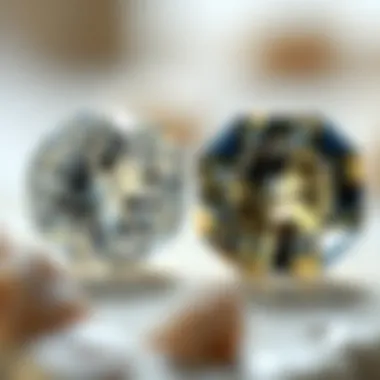
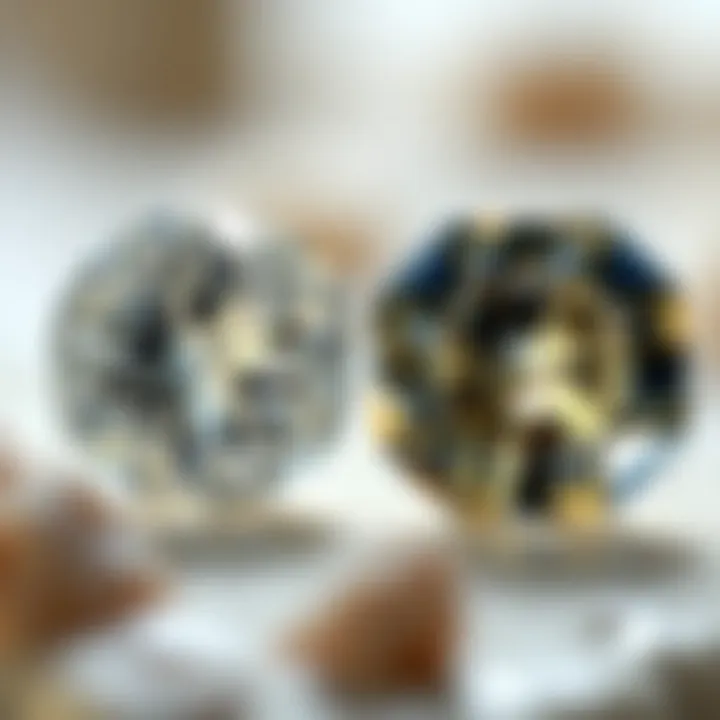
Minerals are naturally occurring substances with a specific chemical composition and crystalline structure. To be classified as a mineral, an entity generally should
- Exist in a solid state,
- Be formed through natural processes,
- Have a consistent chemical formula.
The classification of both natural and synthetic diamond becomes significant here. Although synthetic diamonds are created in labs, their solidity and structure align with traditional definitions of minerals. The complexity lies in determining whether the origin impacts their classification standing.
Characteristics of Diamonds as Minerals
Solid State
Diamonds are an example of material exhibiting a solid state. Their atomic structure is tightly packed, which contributes to their enviable hardness. This characteristic is a crucial aspect of why diamonds are esteemed, harmonizing with the geological definition of minerals. Importantly, solid-state also allows for unique interaction with light, giving diamonds their famed sparkle. This solid state makes diamonds a popular choice for both collectors and jewelers.
Natural Occurrence
The term 'natural occurrence' traditionally relates to how diamonds are formed in the earth's mantle over millions of years. However, laboratory-created diamonds challenge this notion as they are artificially synthesized in controlled environments. While they mimic their natural counterparts in visual appeal and physical properties, their lack of natural formation raises debates about classification. The unique feature of lab-created diamonds is their ability to provide a more sustainable and ethical alternative. However, this artificial origin may influence their perceived value on the market.
Definite Chemical Formula
Diamonds, both natural and lab-made, consist of carbon atoms arranged in a crystal lattice structure, which qualifies them as having a definite chemical formula (C). This is a critical aspect of their classification as minerals since a consistent chemical makeup is fundamental in mineralogy. The clarity of this characteristic serves as a strong point in supporting the classification of synthetic diamonds as minerals. Yet, the irony lies in the consumer perception; many still regard natural diamonds as superior, despite both types belonging to the same chemical category.
For further reading on mineral classification, you might explore resources such as Britannica or Wikipedia.
Societal and Economic Implications
The rise of laboratory-created diamonds has fundamentally shifted the landscape of the gemstone industry. It's not just about sparkling rocks anymore; the perception, market dynamics, and ethical discussions surrounding these stones encompass broader societal contexts. Understanding these implications provides a comprehensive overview of how synthetic diamonds fit into today's world.
Perception of Synthetic Diamonds
Synthetic diamonds have often faced a mixed bag of perceptions among consumers. For some, they represent innovation, embodying technological advancement and eco-friendly alternatives to traditional mining. Proponents argue that these diamonds offer the same aesthetic and structural qualities as natural diamonds, often at a fraction of the cost. However, for others, the term "synthetic" carries a negative connotation, conjuring images of artificiality that question their value in comparison to natural gemstones.
"People often see them as lesser even when they perform identically. It's a tough image to shake off, despite their qualities."
Although awareness is slowly changing, many individuals still connect emotional resonance with natural diamonds, often linked to sentimental occasions such as engagements. This emotional tie can overshadow the benefits of synthetic options. To counteract this, awareness campaigns are seeking to highlight the durability and ethical aspects of lab-created diamonds, focusing on their environmental and socio-economic advantages.
Market Trends for Laboratory-Created Diamonds
The market for lab-grown diamonds is not just a passing trend; it's rapidly gaining traction. Current research suggests that the demand for synthetic diamonds is set to outpace that of natural ones in the coming years. The average price of lab-created stones continues to drop while their popularity rises. This phenomenon can be attributed to factors such as:
- Consumer Education: As more individuals are educated about the similarities in quality and the differences in sourcing, purchased preferences can shift.
- Affordability: The average cost of lab diamonds is often significantly lower than mined diamonds, making them accessible to a broader spectrum of buyers.
- Design Innovation: Jewelry designers are increasingly integrating lab-created stones into their collections, further normalizing their presence in the market.
Market projections indicate growth that could reshape not just consumer behavior but also business practices in the gemstone industry. Retailers are beginning to adapt, with some even shifting their focus completely towards synthetic diamonds to capitalize on changing consumer sentiment.
Ethical Considerations
Ethics play a crucial role in the discussion around laboratory-created diamonds. Natural diamond mining has long been mired in controversies, including environmentally destructive practices and human rights abuses connected to conflict diamonds. In contrast, lab-created diamonds typically pursue more ethical sourcing and production methods, leading many to view them as the more socially responsible choice.


Some key points of ethical consideration include:
- Reduced Environmental Impact: As lab diamonds require no mining, they help to mitigate disturbances to ecosystems and minimize carbon footprints.
- Transparency: Consumers often have more access to information about the sourcing and making of synthetic diamonds, enhancing their ability to make informed choices.
- Job Creation: The burgeoning lab-created diamond industry has the potential to create new jobs in technology and manufacturing sectors that focus on sustainability and innovation.
Ultimately, the choice between synthetic and natural diamonds has diverse implications, and the growing acceptance of lab-created options suggests a shift toward more ethical consumerism in the gemstone market. The continued dialogue around these topics remains vital for collectors and enthusiasts, shaping their understanding of value in a landscape that’s evolving before our eyes.
For further insights, readers may want to explore additional resources:
Wikipedia on Diamonds,
Britannica on Lab-Created Diamonds,
Reddit Discussions on Synthetic Diamonds.
Implications for Collectors and Enthusiasts
The landscape of gem and mineral collecting has evolved with the introduction of laboratory-created diamonds. For collectors, this shift carries both opportunities and challenges. Emphasizing the role of synthetic diamonds in modern collections not only invites a broader appreciation of these stones but also raises questions regarding their status and value in a market traditionally dominated by natural diamonds. As we delve deeper into this topic, collectors can gain insights into how these artificial gems fit into their passion for geology and aesthetics.
Laboratory Diamonds in Collecting
Laboratory-created diamonds are making waves in the collecting community. These stones, while chemically identical to their natural counterparts, enable enthusiasts to diversify their collections. From a geological perspective, they offer a unique opportunity to explore the processes by which diamonds are synthesized. Collectors might find that their allure lies not just in beauty but in the science behind their creation.
Purchasing synthetic diamonds can be a cost-effective way to build a collection. Here are some points to consider:
- Cohesive Themes: Collectors can assemble groups focused solely on synthetic stones, reflecting a commitment to innovation in gemology.
- Educational Value: Understanding the synthesis processes (like HPHT and CVD) can enrich one's knowledge in the field of geology, providing a deeper appreciation for the material.
- Sustainability: Synthetic diamonds are often marketed as more environmentally friendly, appealing to eco-conscious collectors.
Collectors are encouraged to approach laboratory diamonds with an open mind, acknowledging that while they may not bear the storied history of natural diamonds, they represent significant advancements in technology and sustainability.
Valuation of Synthetic vs. Natural Diamonds
The conversation about valuing diamonds is nuanced and layered. Synthetic diamonds generally come with a lower price tag, largely due to their availability and the absence of the mining processes associated with natural stones. However, this doesn’t diminish their significance in the eyes of many collectors. Here are some factors that figure into valuation comparisons:
- Market Perception: Many buyers still prefer natural diamonds for their perceived rarity and historical value, which can inflate their market prices.
- Gem Quality: Despite being man-made, high-quality lab-created diamonds can showcase superior characteristics such as clarity and color, potentially matching or exceeding natural diamonds.
- Rarity Factors: Natural diamonds come with an element of geographic and historical rarity; synthetic diamonds do not, making certain collectors question their long-term collectible value.
Ultimately, the value of both types of diamonds will likely converge as societal norms evolve and education about synthetic diamonds continues. Collectors should stay informed about market trends and adjust their collections accordingly, ensuring they reflect their values and aspirations.
Additionally, resources like Wikipedia and Britannica can offer valuable insights into the geological implications of both natural and synthetic diamonds, aiding collectors in making informed decisions.
Culmination and Future Perspectives
In concluding this exploration of laboratory-created diamonds, it is crucial to synthesize our findings on their classification, societal impacts, and future trajectories. As we’ve unraveled throughout this article, the distinction between natural and synthetic diamonds is not just a matter of origin; it fundamentally shapes the way we perceive these gemstones. The conversation around whether lab-created diamonds qualify as minerals continues to spur debate among scientists, collectors, and enthusiasts alike.
Summarizing the Classification Debate
To summarize the classification discourse, it’s manifest that the definition of a mineral is central to determining whether laboratory diamonds can be classified as such. A mineral is typically defined by criteria like its solid-state, natural occurrence, and specific chemical composition. Laboratory diamonds, created through methods like High Pressure High Temperature or Chemical Vapor Deposition, meet many of these criteria: they are solid and have a defined chemical structure consistent with their natural counterparts.
It would be remiss to overlook the conventional wisdom that is often resistant to change. Yet, as technology advances, our definitions may need to evolve.
For enthusiasts and collectors, this debate creates a rich tapestry of discussion. The more refined our understanding becomes, the better equipped we are to appreciate these stones, whether mined or created. It seems the line between natural and synthetic is increasingly blurred, posing essential queries about value, desirability, and authenticity in the realm of diamonds. As this classification question remains open, it fosters an environment of continuous discovery and learning.
The Future of Diamond Production
Looking ahead, the future of diamond production appears bright and promising. As production techniques continue to refine and innovate, the implications for both economics and ethics within the gemstone market are significant. Laboratory-created diamonds are not simply an alternative; they mark a shift toward more sustainable practices in gemstone sourcing. In light of consumer awareness and environmental concerns, lab-created diamonds can offer a more ethical solution, almost as a breath of fresh air in a traditionally ‘dirty’ industry.
The market share for these gemstones is expected to expand, potentially reaching parity with natural diamonds. As technology becomes cheaper and more accessible, we could witness a surge in amateur diamond enthusiasts experimenting with synthesis in their labs.
In sum, the journey of laboratory-created diamonds is one of growth and potential. As we stand at this crossroads, there lies an opportunity—an oft-overlooked moment where curiosity meets ingenuity. Understanding this evolution allows us to not only appreciate the artistry that is involved in diamond creation but also instills a sense of accountability towards our planet and resources. Looking forward, one can only wonder how these fascinating gemstones will continue to reshape the landscape of gemology and society at large.
For more in-depth information, explore additional resources such as Wikipedia on Diamonds, or Britannica on Synthetic Diamonds.



